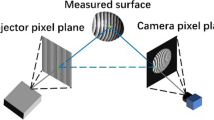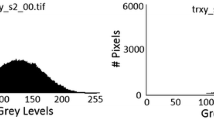Abstract
Two-dimensional digital image correlation (2D-DIC) is increasingly being used in a wide variety of applications. This technique is capable of measuring the in-plane deformations and strains of planner surfaces. A basic condition for using this technique is having the camera to observe the target surface perpendicularly. If the camera is not perpendicular to the surface, errors will be introduced in the measured displacements and strains. Small amounts of camera misalignment can easily go undetected during the initial setting of the experimental setup. In this paper, a novel approach for verifying the perpendicularity of the camera with respect to the target surface in 2D-DIC experiments is introduced. If the camera is not perpendicular to the surface, the tilt angles about both of the two in-plane axes can be calculated using this novel approach. A simple in-plane rigid-body-translation of the specimen in any of the two in-plane directions (horizontal or vertical direction relative to the camera image), is used for detecting camera non-perpendicularity and calculating the tilt angle(s). This approach uses the normal and shear strain errors, induced in DIC results due to camera non-perpendicularity, to determine the surface tilt angle(s), if any is present. The tilt angle(s) are calculated using simple analytical equations that are developed based on the pinhole camera model. The proposed approach is validated using experiments performed while the target surface is tilted at angles ranging from 0.5° to 4°. The experimental results show that this approach is able to confidently detect camera misalignment for tilt angles of 1° or larger and the tilt angles can be calculated with less than 0.3° error.















Similar content being viewed by others
Change history
27 December 2019
The original article has been corrected on the line “These two parameters are the average…” and on Eqs. 19, 20, 21 and 23.
References
Sutton M, Wolters W, Peters W, Ranson W, McNeill S (1983) Determination of displacement using an improved digital correlation method. Image Vis Comput 1:133–139
Sutton M, McNeill S, Helm J, Chao Y (2000) Advances in two-dimensional and three-dimensional computer vision. In: Rastogi P (ed) Topics in applied physics, vol 77. Springer, Berlin, pp 323–372
Sutton M, Orteu J, Schreier H (2009) Image correlation for shape, motion and deformation measurements. Springer, New York
Pan B, Qian K, Xie H, Asundi A (2009) Two-dimensional digital image correlation for in-plane displacement and strain measurement: a review. Meas Sci Technol 20:062001 (17pp)
Orteu J (2009) 3-D computer vision in experimental mechanics. Opt Lasers Eng 47:282–291
Hild F, Roux S (2006) Digital image correlation: from displacement measurement to identification of elastic properties–a review. Strain 42:69–80
Feng D, Feng M (2016) Vision-based multipoint displacement measurement for structural health monitoring. Struct Control Health Monit 23:876–890
Helfrick M, Niezrecki C, Avitabile P, Schmidt T (2011) 3D digital image correlation methods for full-field vibration measurement. Mech Syst Signal Process 25:917–927
Hijazi A, Yardi N, Madhavan V (2004) Determination of forming limit curves using 3D digital image correlation and in-situ observation. Proceedings of the International SAMPE Symposium and Exhibition, Long Beach, CA, pp. 16–20
Liljenhjerte J, Upadhyaya P, Kumar S (2016) Hyperelastic strain measurements and constitutive parameters identification of 3d printed soft polymers by image processing. Additive Manufact 11:40–48
Caminero M, Lopez-Pedrosa M, Pinna C (2013) And Soutis. C. Damage monitoring and analysis of composite laminates with an open hole and adhesively bonded repairs using digital image correlation. Compos Part B 53:76–91
Eshtayeh M, Hijazi A, Hrairi M (2015) Nondestructive evaluation of welded joints using digital image correlation. J Nondestruct Eval 34:37
Libertiaux V, Pascon F, Cescotto S (2011) Experimental verification of brain tissue incompressibility using digital image correlation. J Mech Behav Biomed Mater 4:1177–1185
Soltani A, Curtze S, Lahti J, Järvelä K, Laurikka J, Hokka M, Kuokkala V (2018) Digital Image Correlation Study of the Deformation and Functioning of the Human Heart during Open-Heart Surgery. In Mechanics of Biological Systems, Materials and other topics in Experimental and Applied Mechanics, Springer: Cham 4: 19–27
Sutton M, Li N, Joy D, Reynolds A, Li X (2007) Scanning electron microscopy for quantitative small and large deformation measurements part I: SEM imaging at magnifications from 200 to 10,000. Exp Mech 47:775–787
Kirugulige M, Hareesh S, Tippur V, Denney T (2007) Measurement of transient deformations using digital image correlation method and high-speed photography: application to dynamic fracture. Appl Opt 46:5083–5096
Hijazi A, Madhavan V (2008) A novel ultra-high speed camera for digital image processing applications. Meas Sci Technol 19:085503
Luo P, Chao Y, Sutton M, Peters W (1993) Accurate measurement of three-dimensional deformations in deformable and rigid bodies using computer vision. Exp Mech 33:123–132
Hijazi A, Kähler C (2017) Contribution of the imaging system components in the overall error of the two-dimensional digital image correlation technique. J Test Eval 45:369–384
Haddadi H, Belhabib S (2008) Use of rigid-body motion for the investigation and estimation of the measurement errors related to digital image correlation technique. Opt Lasers Eng 46:185–196
Bornert M et al (2009) Assessment of digital image correlation measurement errors: methodology and results. Exp Mech 49:353–370
Chu T, Ranson W, Sutton M, Peters W (1984) Applications of digital-image-correlation techniques to experimental mechanics. Exp Mech 25:232–244
Sutton M, Yan J, Tiwari V, Schreier H, Orteu J (2008) The effect of out-of-plane motion on 2D and 3D digital image correlation measurements. Opt Lasers Eng 46:746–757
Pan B, Yu L, Wu D (2013) High-accuracy 2D digital image correlation measurements with bilateral telecentric lenses: error analysis and experimental verification. Exp Mech 53:1719–1733
Pan B, Yu L, Wu D (2013) High-accuracy 2D digital image correlation measurements using low-cost imaging lenses: implementation of a generalized compensation method. Meas Sci Technol 25:025001
Siddiqui M (2015) Towards eliminating the displacement Bias due to out-of-plane motion in 2D inverse problems: a case of general rigid-body motion. Strain 51:55–70
Badaloni M, Lava P, Rossi M, Chiappini G, Debruyne D (2016) Out-of-plane motion evaluation and correction in 2D DIC. Adv Optic Methods Experiment Mech, Springer: Cham, Vol. 3, pp. 181–187
Meng L, Jin G, Yao X (2006) Errors caused by misalignment of the optical camera axis and the object surface in the DSCM. J Tsinghua Univ: Sci Technol 46:1930–1932
Lava P, Coppieters S, Wang Y, Van-Houtte P, Debruyne D (2011) Error estimation in measuring strain fields with DIC on planar sheet metal specimens with a non-perpendicular camera alignment. Opt Lasers Eng 49:57–65
Hijazi A, Friedl A, Kähler C (2011) Influence of camera’s optical axis non-perpendicularity on measurement accuracy of two-dimensional digital image correlation. JJMIE 5:373–382
MatchID-2D manual: < www.MatchID.org >
Acknowledgements
The experiments were done in the Metrology laboratory of the Mechanical Engineering Department at King Abdul-Aziz University.
Author information
Authors and Affiliations
Corresponding author
Additional information
Publisher’s Note
Springer Nature remains neutral with regard to jurisdictional claims in published maps and institutional affiliations.
Exemplary speckle pattern image files with 2° camera tilt angle are available online.
The original version of this article was revised: corrected on the line “These two parameters are the average…” and on equations 19,20,21 and 23.
Electronic supplementary material
ESM 1
Exemplary speckle pattern image files with 2° camera tilt angle (RAR 1731 kb)
Rights and permissions
About this article
Cite this article
Hijazi, A.L. A Novel Approach for the Determination of Surface Tilt Angles in Two-Dimensional Digital Image Correlation Experiments. Exp Mech 60, 267–282 (2020). https://doi.org/10.1007/s11340-019-00554-8
Received:
Accepted:
Published:
Issue Date:
DOI: https://doi.org/10.1007/s11340-019-00554-8




